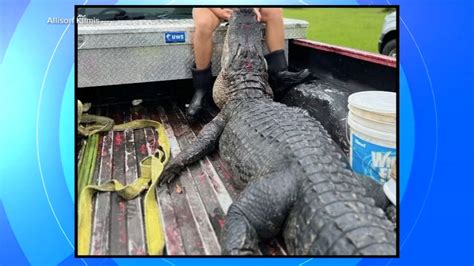
Rescue efforts were complicated and delayed by the presence of alligators following a fatal single-vehicle crash in Florida involving a teenager. The vehicle plunged into a retention pond late Sunday night, and first responders faced challenges due to the aggressive reptiles inhabiting the water, hindering their ability to quickly reach the victim.
Authorities responded to the scene near the intersection of State Road 44 and Grand Avenue in DeLand, Florida, after receiving reports of a car submerged in a pond. According to the Volusia County Sheriff’s Office, the 17-year-old driver, identified as Emma Brennan, was pronounced dead at the scene. The incident occurred around 11:40 p.m. on Sunday.
“Deputies and rescue personnel responded to the scene Sunday night and immediately faced a major obstacle: multiple alligators in the water,” the sheriff’s office stated in a press release. The presence of the alligators necessitated additional precautions to ensure the safety of the rescue personnel, delaying the extraction of the victim and the vehicle.
The investigation into the cause of the crash is ongoing, and authorities are examining factors that may have contributed to the incident. The Florida Fish and Wildlife Conservation Commission (FWC) was also notified and assisted in managing the alligator threat.
The tragic event highlights the dangers posed by Florida’s wildlife and the challenges faced by first responders in such situations. The incident has prompted renewed discussions about safety measures near bodies of water inhabited by alligators and the protocols for conducting rescue operations in these environments.
The Incident and Initial Response
On the night of the accident, local authorities received a call reporting a vehicle that had driven into a retention pond near the intersection of State Road 44 and Grand Avenue in DeLand. Upon arrival, deputies from the Volusia County Sheriff’s Office confirmed the presence of a car submerged in the water.
The immediate priority was to locate and extract any occupants from the vehicle. However, the rescue operation was quickly complicated by the presence of multiple alligators in the pond. These reptiles, known for their territorial and predatory behavior, posed a significant threat to the safety of the first responders attempting to enter the water.
“The alligators definitely hampered rescue efforts,” said a spokesperson for the Volusia County Sheriff’s Office. “We had to take extra precautions to ensure the safety of our personnel while trying to reach the victim.”
The presence of alligators in Florida waterways is not uncommon. The state is home to a large population of these reptiles, and they are frequently found in lakes, ponds, rivers, and canals. While alligators typically avoid human interaction, they can become aggressive, particularly during mating season or if they feel threatened.
To mitigate the risk, the Volusia County Sheriff’s Office coordinated with the Florida Fish and Wildlife Conservation Commission (FWC). The FWC provides expertise and resources for managing wildlife encounters and ensuring public safety. Their involvement was crucial in assessing the alligator threat and implementing measures to protect the rescue personnel.
The Victim and Community Impact
The victim of the crash was identified as 17-year-old Emma Brennan. She was a resident of the local community and a student at a nearby high school. News of her tragic death has deeply affected her family, friends, and classmates.
Grief counselors have been made available at the school to provide support to students and staff. A memorial service is being planned to honor Emma’s life and offer an opportunity for the community to come together in mourning.
“Emma was a bright and promising young woman with a bright future ahead of her,” said a close friend. “She will be deeply missed by everyone who knew her.”
The accident has also raised concerns about the safety of roadways located near bodies of water. Residents are calling for increased safety measures, such as guardrails and warning signs, to prevent similar incidents from occurring in the future.
Alligator Management and Safety Protocols
The presence of alligators in Florida necessitates specific safety protocols and management strategies. The FWC plays a leading role in managing the alligator population and educating the public about how to coexist safely with these reptiles.
According to the FWC, the most important rule is to never feed alligators. Feeding alligators can cause them to lose their natural fear of humans and associate people with food, leading to potentially dangerous encounters. It is also illegal to feed alligators in Florida.
Other safety tips include:
- Keep a safe distance from alligators.
- Do not swim in areas known to be inhabited by alligators, especially at dusk and dawn.
- Keep pets on a leash and away from the water’s edge.
- Never approach or harass alligators.
- If you see an alligator displaying aggressive behavior, contact the FWC immediately.
The FWC also operates a statewide nuisance alligator hotline. If an alligator poses a threat to people or property, the FWC can dispatch a contracted alligator trapper to remove the animal.
In situations like the DeLand crash, where alligators impede rescue efforts, specialized protocols are followed to ensure the safety of first responders. These protocols may involve using boats or other equipment to create a barrier between the alligators and the rescue personnel, or temporarily relocating the alligators to a safer area.
Investigation into the Cause of the Crash
The Volusia County Sheriff’s Office is conducting a thorough investigation into the cause of the single-vehicle crash. Investigators are examining various factors that may have contributed to the accident, including:
- Driver error: Investigators will analyze Emma’s driving record and consider whether any errors or misjudgments may have led to the crash.
- Vehicle malfunction: The vehicle will be inspected for any mechanical defects or malfunctions that could have caused the driver to lose control.
- Road conditions: Investigators will assess the road conditions at the time of the accident, including visibility, weather, and any potential hazards.
- Distracted driving: Authorities will determine if Emma was using her cell phone or engaging in any other distracting activities while driving.
- Impairment: While the investigation is ongoing, authorities will consider the possibility of impairment.
The investigation is expected to take several weeks to complete. Once finished, the findings will be released to the public. The results of the investigation could lead to recommendations for improving road safety and preventing similar accidents in the future.
Community Reactions and Safety Concerns
The tragic incident has sparked a wave of grief and concern within the DeLand community. Residents are expressing their condolences to the family of Emma Brennan and calling for action to prevent future tragedies.
Many residents are questioning the safety of roadways located near bodies of water. They argue that more needs to be done to protect drivers from the risk of accidents. Some specific suggestions include:
- Installation of guardrails: Guardrails can act as a barrier to prevent vehicles from veering off the road and into the water.
- Improved signage: Warning signs can alert drivers to the presence of nearby bodies of water and the potential for wildlife encounters.
- Increased lighting: Better lighting can improve visibility and make it easier for drivers to navigate roadways at night.
- Speed reduction: Lowering the speed limit on roads near bodies of water can give drivers more time to react to unexpected hazards.
Local officials have acknowledged the community’s concerns and pledged to review safety measures in the area. They are working with transportation experts and community leaders to identify potential solutions and implement necessary improvements.
“We are committed to ensuring the safety of our residents and visitors,” said a spokesperson for the city of DeLand. “We will carefully consider all available options and take appropriate action to prevent future accidents.”
The incident also serves as a reminder of the importance of safe driving practices. Drivers are urged to always:
- Obey traffic laws.
- Avoid distractions while driving.
- Drive at a safe speed.
- Be aware of their surroundings.
- Never drive under the influence of alcohol or drugs.
Long-Term Implications and Prevention Efforts
The fatal crash in DeLand has far-reaching implications for the community and beyond. It highlights the need for ongoing efforts to improve road safety, manage wildlife populations, and educate the public about potential hazards.
In the long term, the incident could lead to:
- Changes in state and local regulations: Authorities may consider implementing new regulations related to road construction, wildlife management, and driver education.
- Increased funding for safety initiatives: Government agencies may allocate more funding to support safety initiatives, such as the installation of guardrails and improved signage.
- Greater awareness of the risks associated with driving near bodies of water: Public awareness campaigns can help to educate drivers about the potential dangers and promote safe driving practices.
Preventing similar accidents in the future will require a multi-faceted approach that involves collaboration between government agencies, community organizations, and individual citizens. By working together, it is possible to create a safer environment for everyone.
The tragedy serves as a stark reminder of the fragility of life and the importance of taking precautions to protect ourselves and others from harm. As the community mourns the loss of Emma Brennan, they are also committed to honoring her memory by working to prevent similar tragedies from occurring in the future.
Continued Challenges and Future Considerations
While the immediate aftermath of the tragic accident in DeLand has focused on grief, investigation, and community response, several long-term challenges and future considerations remain. These include addressing the systemic issues that contribute to such accidents, improving emergency response protocols, and promoting greater awareness of the risks associated with Florida’s unique environment.
One critical challenge is balancing development and conservation. As Florida’s population continues to grow, more roads are being built near bodies of water and wildlife habitats. This increases the potential for conflicts between humans and animals, as well as the risk of accidents like the one in DeLand. Careful planning and responsible development practices are essential to minimize these risks.
Another challenge is improving emergency response protocols in areas with significant wildlife populations. First responders need specialized training and equipment to safely and effectively handle situations involving alligators or other dangerous animals. This includes having access to boats, barriers, and other tools that can be used to protect rescue personnel while they are working to save lives.
Furthermore, there is a need for greater public awareness of the risks associated with driving near bodies of water and interacting with wildlife. Educational campaigns can help to inform drivers about the potential dangers and promote safe driving practices. They can also teach people how to coexist safely with alligators and other animals, reducing the likelihood of dangerous encounters.
Finally, ongoing research is needed to better understand the behavior of alligators and other wildlife, as well as the factors that contribute to accidents involving these animals. This research can inform the development of more effective safety measures and management strategies.
The DeLand crash is a tragic reminder of the complex challenges facing communities in Florida and other areas with significant wildlife populations. By addressing these challenges proactively and working together, it is possible to create a safer and more sustainable future for all.
The Volusia County Sheriff’s Office and the Florida Fish and Wildlife Conservation Commission continue to work in collaboration to address the concerns raised by this incident. They are committed to providing resources and support to the community and ensuring that lessons are learned from this tragedy. The focus remains on preventing similar incidents and protecting the safety of all residents and visitors.
Quote Consolidation from Original Source:
- “Deputies and rescue personnel responded to the scene Sunday night and immediately faced a major obstacle: multiple alligators in the water,” – Volusia County Sheriff’s Office
- “The alligators definitely hampered rescue efforts,” said a spokesperson for the Volusia County Sheriff’s Office. “We had to take extra precautions to ensure the safety of our personnel while trying to reach the victim.”
FAQ Section:
Frequently Asked Questions (FAQs) about the DeLand Crash and Alligator Safety
1. What happened in the DeLand, Florida, crash?
A 17-year-old girl, Emma Brennan, died after her vehicle plunged into a retention pond near State Road 44 and Grand Avenue in DeLand, Florida. The presence of multiple alligators in the water hampered and delayed rescue efforts.
2. How did the alligators affect the rescue operation?
The presence of multiple alligators posed a significant safety risk to first responders attempting to reach the submerged vehicle and extract the victim. The alligators’ presence required additional precautions, slowing down the rescue efforts as rescuers had to ensure their own safety while trying to reach the victim. According to a spokesperson from the Volusia County Sheriff’s Office, “The alligators definitely hampered rescue efforts,” forcing them to “take extra precautions.”
3. What is being done to investigate the cause of the crash?
The Volusia County Sheriff’s Office is conducting a thorough investigation into the cause of the crash. This includes examining driver error, vehicle malfunction, road conditions, distracted driving, and potential impairment. The investigation aims to determine the factors that contributed to the accident and prevent similar incidents in the future.
4. What safety measures are recommended for living near or driving by bodies of water with alligators?
Safety recommendations include never feeding alligators, keeping a safe distance from them, avoiding swimming in alligator-inhabited areas, keeping pets on a leash, never approaching or harassing alligators, and contacting the FWC if an alligator displays aggressive behavior. When driving near water, maintaining awareness of surroundings, obeying traffic laws, and avoiding distractions are crucial. Guardrails, warning signs, and increased lighting can improve road safety.
5. What is the Florida Fish and Wildlife Conservation Commission (FWC)’s role in managing alligators, and what should I do if I encounter a nuisance alligator?
The FWC manages the alligator population in Florida and educates the public on how to coexist safely with these reptiles. If you encounter an alligator that poses a threat to people or property, contact the FWC’s nuisance alligator hotline. The FWC can then dispatch a contracted alligator trapper to remove the animal. It’s also illegal to feed alligators in Florida.
6. What immediate support was provided to the community and school following Emma Brennan’s death?
Grief counselors were made available at Emma Brennan’s school to provide support to students and staff. The community began planning a memorial service to honor Emma’s life and provide an opportunity for collective mourning and support.
7. What are some long-term solutions being considered to prevent similar accidents in the future?
Long-term solutions include potential changes in state and local regulations regarding road construction and wildlife management, increased funding for safety initiatives like guardrails and improved signage, and public awareness campaigns to educate drivers about the risks of driving near bodies of water.
8. How are local officials responding to community concerns about road safety near bodies of water?
Local officials have acknowledged the community’s concerns and have pledged to review safety measures in the area. They are working with transportation experts and community leaders to identify potential solutions and implement necessary improvements to enhance road safety near bodies of water.
9. What specific safety protocols are in place for first responders dealing with wildlife during rescue operations?
First responders in areas with significant wildlife populations receive specialized training and have access to equipment to handle situations involving dangerous animals. Protocols may include using boats to create barriers, temporarily relocating animals, and utilizing specialized tools to ensure the safety of rescue personnel while performing their duties.
10. What is the significance of responsible development practices in areas with wildlife habitats?
As Florida’s population grows and development expands, it’s crucial to balance development with conservation efforts. Responsible development practices are essential to minimize conflicts between humans and animals and to reduce the risk of accidents. Careful planning and adherence to environmental regulations can help protect wildlife habitats and prevent dangerous encounters.









